Mystrium oberthueri
| Mystrium oberthueri | |
|---|---|

| |
| Scientific classification | |
| Kingdom: | Animalia |
| Phylum: | Arthropoda |
| Class: | Insecta |
| Order: | Hymenoptera |
| Family: | Formicidae |
| Subfamily: | Amblyoponinae |
| Tribe: | Amblyoponini |
| Genus: | Mystrium |
| Species group: | voeltzkowi |
| Species: | M. oberthueri |
| Binomial name | |
| Mystrium oberthueri Forel, 1897 | |
Mystrium are predators that specialize on capturing large centipedes. Mystrium oberthueri is an inhabitant of primary rainforest in Madagascar. Colonies nest mostly in damp rotten wood on the ground, including small branches and root mats. Emigrations are common and may be relatively frequent e.g. when branches decay or dry up. M. oberthueri colonies average 40 adults with typically half being ergatoid queens. The latter are smaller than the workers but only 5% are mated and reproduce. Ergatoid queens do not disperse from their natal nest, and colonies multiply by fission. Virgin queens are specialized in brood care and intranidal tasks, whereas workers focus on foraging and nest defence (Bouchet et al. 2013, Molet et al. 2007a, 2007b, 2009).
| At a Glance | • Ergatoid queen • Polygynous |
Identification
The worker of Mystrium oberthueri is easily distinguished from that of other Mystrium species by the combination of the following characters: strong, deep, and thick longitudinal sculpture on the dorsal and lateral surface of pronotum; straight anteromedial margin of the clypeus; a sharper angle between the dorsal and posterior faces of the vertex on the median line of the head. The queen of M. oberthueri is differentiated from other queens of Mystrium species by the vestigial wings reduced to small appendages with undeveloped wing sclerites (ergatoid), the posterior face of the vertex forming approximately a right angle with its dorsal face on the median line of the head, straight anterior clypeal margin (Fig. 22B), and moderately developed clypeal conical setae. The male of M. oberthueri can be separated from the other known Mystrium males by its smooth abdominal tergum VIII, small lateral ocelli situated distant from posterior margin of head in full-face view, and straight dorsal margin of head in full-face view. (Yoshimura and Fisher 2014)
Keys including this Species
Distribution
Latitudinal Distribution Pattern
Latitudinal Range: -12.09949° to -21.22284°.
| North Temperate |
North Subtropical |
Tropical | South Subtropical |
South Temperate |
- Source: AntMaps
Distribution based on Regional Taxon Lists
Malagasy Region: Madagascar (type locality).
Distribution based on AntMaps
Distribution based on AntWeb specimens
Check data from AntWeb
Countries Occupied
| Number of countries occupied by this species based on AntWiki Regional Taxon Lists. In general, fewer countries occupied indicates a narrower range, while more countries indicates a more widespread species. |

|
Estimated Abundance
| Relative abundance based on number of AntMaps records per species (this species within the purple bar). Fewer records (to the left) indicates a less abundant/encountered species while more records (to the right) indicates more abundant/encountered species. |

|
Habitat
Primary rainforest.
Biology
Colony Emigration
Bouchet et al. (2013) - Our observations show that colony emigration in M. oberthueri is a well-coordinated process. Workers, except for youngest ones, initiate the emigration and perform numerous return trips to recruit nestmates. They also carry brood items, probably lay a chemical trail, and end the emigration by performing more visits to the old nest, probably to check for any remaining nestmates or brood. Queens are also actively involved in the emigration process. First, just like workers, a few non-reproductive queens can be present in the new nest before emigration and thus contribute to the exploration of potential nesting sites. This contrasts with Molet et al . (2007b), who found that queens stayed in the nest. Secondly, queens participate in recruitment (through return trips) and brood transport. Nevertheless, just like young workers, reproductive queens and young non-reproductive queens generally do not perform these tasks, and limit themselves to one direct trip without brood transport. Despite its peculiar caste system, M. oberthueri relocates its nests using a similar pattern of polyethism as monogynous species such as Aphaenogaster senilis (Avargues-Weber & Monnin, 2009). Individuals with experience of the outside world (older workers in M. oberthueri, ‘outside workers’ in A. senilis) are very active. Inexperienced individuals (non-reproductive queens and young individuals in M. oberthueri, ‘inside workers’ in A. senilis) are less involved. Young individuals and reproductive queens preferentially move directly to the new nest, avoiding return trips and brood transport, so they are less exposed to danger. In M. oberthueri colonies, the physiological status of each individual has more impact on its behavioural profile during emigration than its morphological caste.
Predation
Although remains of centipede prey have been found inside nests, predation has not been observed directly and may be nocturnal. It is thought that Mystrium ants hunt in group.
Queens are ergatoid and mating occurs close to the entrance of their natal nests. Afterwards they return inside. There is no independent colony foundation (Molet et al. 2009).
Castes
Worker
Images from AntWeb
 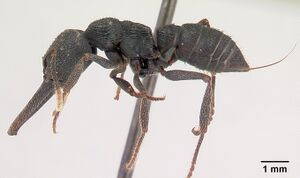 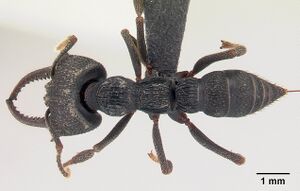 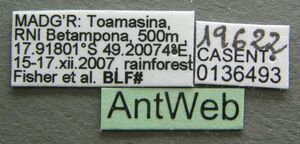
| |
| Worker. Specimen code casent0136493. Photographer Erin Prado, uploaded by California Academy of Sciences. | Owned by CAS, San Francisco, CA, USA. |
   
| |
| Paralectotype of Mystrium oberthueri. Queen (ergatoid). Specimen code casent0101949. Photographer April Nobile, uploaded by California Academy of Sciences. | Owned by MHNG, Geneva, Switzerland. |
  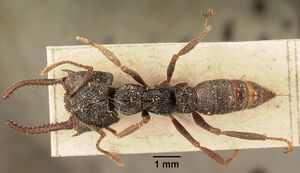 
| |
| Lectotype of Mystrium oberthueri. Worker. Specimen code casent0101993. Photographer April Nobile, uploaded by California Academy of Sciences. | Owned by MHNG, Geneva, Switzerland. |
   
| |
| Worker. Specimen code casent0141843. Photographer Erin Prado, uploaded by California Academy of Sciences. | Owned by CAS, San Francisco, CA, USA. |
 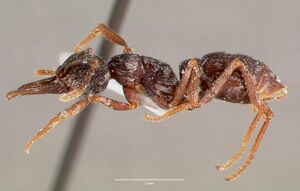  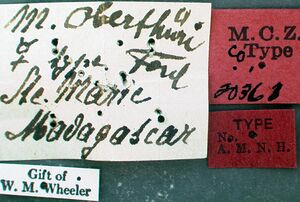
| |
| Paralectotype of Mystrium oberthueri. Queen (ergatoid). Specimen code mcztype20363. Photographer April Nobile, uploaded by California Academy of Sciences. | Owned by MCZ, Cambridge, MA, USA. |
Male
Images from AntWeb
     
| |
| Male (alate). Specimen code casent0179499. Photographer Erin Prado, uploaded by California Academy of Sciences. | Owned by CAS, San Francisco, CA, USA. |
Nomenclature
The following information is derived from Barry Bolton's Online Catalogue of the Ants of the World.
- oberthueri. Mystrium oberthueri Forel, 1897c: 192 (w.) MADAGASCAR.
- Type-material: lectotype worker (by designation of Yoshimura & Fisher, 2014: 84), 2 paralectotype ergatoid queens.
- Type-locality: lectotype Madagascar: Insel Ste Marie (Perrot); paralectotypes with same data.
- Type-depository: MHNG.
- [Mystrium oberthueri Wasmann, 1897: 250. Nomen nudum (attributed to Forel).]
- Emery, 1899f: 267 (m.); Yoshimura & Fisher, 2014: 85 (w.ergatoid q.m.).
- Status as species: Emery, 1899f: 267; Emery, 1911d: 23; Wheeler, W.M. 1922a: 1006; Menozzi, 1929d: 530 (redescription); Brown, 1960a: 170; Bolton, 1995b: 287; Yoshimura & Fisher, 2014: 85 (redescription).
- Distribution: Madagascar.
Type Material
- Lectotype (designated by Yoshimura & Fisher, 2014: 84), worker, Insel Ste. Marie (Island of Sainte Marie), Madagascar, Perrot, CASENT0101993, Musee d'Histoire Naturelle Genève.
Unless otherwise noted the text for the remainder of this section is reported from the publication that includes the original description.
Description
Worker
Yoshimura and Fisher (2014) - Measurements: lectotype. HL 2.40, HW 2.61, SL 1.80, ML 2.92, HD 1.67, WL 2.79, PnW 1.39, PpW 1.21, PtW 1.18, PtL 0.81, CI 108.7, SI 69.0, MI 111.8, PpI 87.4, PtI 144.9.
HL 2.00–2.58, HW 2.12–2.76, SL 1.55–1.96, ML 2.39–3.17, HD 1.33–1.69, WL 2.43–2.96, PnW 1.17–1.38, PpW 1.02–1.29, PtW 1.00–1.32, PtL 0.67–0.81, CI 104.4–108.5, SI 68.8–74.9, MI 106.9–122.9, PpI 87.2–93.8, PtI 139.5–163.2 (10 specimens measured).
Posterolateral corner of head moderately expanding posteriorly. Posterior face of vertex forming almost right angle with dorsal face on median line of head, so that declivity of vertex on lateral part as steep as on median part. Whole region of vertex finely striated. Eye moderately small. Anterior margin of clypeus straight or weakly convex with long conical setae. Genal tooth of head relatively long, as long as lateral lobe of clypeus. Masticatory surface of mandible almost invisible in full-face view, and width of dorsal surface of mandible almost identical from mandibular shaft to distal portion. Second maxillary palpomere longer than third. First flagellomere (third antennal segment) about 1.2–1.5× length of pedicel (second antennal segment). Strong, deep longitudinal striae regularly impressed on whole central part of pronotal dorsum. Strong, deep longitudinal striae impressed on lateral surface of pronotum. Mesonotum differentiated from propodeum in dorsal view, length slightly shorter than that of propodeum. Metanotal groove shallowly and gently impressed in lateral view. Metapleural gland bulla moderately developed, and propodeal declivity in lateral view almost straight. Petiole widened on posterior 1/3 and gently narrowing anteriorly in dorsal view, anterior margin straight to gently rounded and often edged by thick striae.
Body color black.
Queen
Yoshimura and Fisher (2014) - Ergatoid Measurements: HL 1.40–1.93, HW 1.46–1.96, SL 1.07–1.47, ML 1.49–2.00, HD 1.00–1.35, WL 1.92–2.56, PnW 0.83–1.11, PpW 0.85–1.13, PtW 0.81–1.07, PtL 0.53–0.70, CI 101.6–108.6, SI 71.6–76.7, MI 96.3– 108.8, PpI 96.0–104.4, PtI 149.1–177.1 (10 specimens measured).
Wings vestigial and reduced to small but distinct appendages. Wing sclerites undeveloped. Posterolateral corner of head moderately expanding posteriorly, expansion not differentiated from that in workers. Posterior face of vertex forming almost a right angle with dorsal face on median line of head, so that declivity of vertex on lateral part as steep as on median part. Ventral half of vertex sculptured. Eye small but distinct. Ocelli absent. Anterior margin of clypeus almost straight with long to moderate conical setae. Anterolateral portion of head with short spine. Masticatory margin of mandible almost invisible in full-face view, and dorsal surface on distal portion as wide as that on mandibular shaft. Spatulate seta present on basal side of each basal denticle on masticatory margin of mandible. First flagellomere (third antennal segment) long, about 1.2-1.5× length of pedicel (second antennal segment). Setae on pronotum distinctly spatulate, widened distally with sharp or blunt apex. Metapleural gland bulla moderately developed, not expanding dorsally to propodeal spiracle, so that propodeal declivity in lateral view weakly convex and rounded posteriorly on its ventral 1/3. Petiole relatively long in dorsal view, about 0.8× length of abdominal segment III.
Body color blackish to reddish brown.
Male
Yoshimura and Fisher (2014) - Measurements: HL 1.44, HW 2.09, SL 0.62, EL 0.95, WL 3.55, MnW 1.94, CI 145.1, SI 29.6, EI 66.2, MnI 92.9 (1 specimen measured).
Eye moderately large, occupying 0.6× of head length. Ocelli relatively distant from dorsal margin of head in full-face view. Dorsal margin of head in full-face view straight. Both anterior and lateral ocelli small. Lateral ocellus small and distant from eye: distance between these more than 1.5× maximum diameter of lateral ocellus. Posterior face of vertex not clearly differentiated from dorsal face, so that vertex almost continuously rounded. Palpal formula 4,3. First maxillary palpomere flattened and distinctly wider than second segment. Second maxillary palpomere longer than third. Notauli clearly impressed on mesoscutum. Petiole in dorsal view thin, 0.8× as long as abdominal tergite III. Petiolar dorsum covered with shallow, irregular punctures. Abdominal tergum VIII without deep punctures, almost smooth.
Distal portion of abdominal sternum IX smooth and not punctured. Basal ring moderately long, expanding basoventrally. Telomere distinctly extending distally farther than digitus. Basoventral expansion of aedeagus moderately developed basoventrally, longer than dorsal extension. Ventral margin of aedeagus gently convex in lateral view. Aedeagus moderately narrowing distally and distal portion rounded.
On forewing, cu-a located far basal from junction of Media (M) and Cubitus (Cu).
Body color reddish brown to black.
References
- Bouchet, D. C., C. Peeters, B. L. Fisher & M. Molet. 2013. Both female castes contribute to colony emigration in the polygynous ant Mystrium oberthueri. Ecol. Entomol. 38:408-417.
- Brown, W. L., Jr. 1960a. Contributions toward a reclassification of the Formicidae. III. Tribe Amblyoponini (Hymenoptera). Bulletin of the Museum of Comparative Zoology 122: 143-230.
- Emery, C. 1899e. Formiche di Madagascar raccolte dal Sig. A. Mocquerys nei pressi della Baia di Antongil (1897-1898). Bull. Soc. Entomol. Ital. 31: 263-290 (page 267, male described)
- Forel, A. 1897d. Ameisen aus Nossi-Bé, Majunga, Juan de Nova (Madagaskar), den Aldabra-Inseln und Sansibar, gesammelt von Herrn Dr. A. Voeltzkow aus Berlin. Mit einem Anhang über die von Herrn Privatdocenten Dr. A. Brauer in Marburg auf den Seychellen und von Herrn. Abh. Senckenb. Naturforsch. Ges. 21: 185-208 (page 192, worker described)
- Ito, F., Hashim, R., Gobin, R. 2021. Colony composition in the Oriental ectatommine ant, Gnamptogenys menadensis in Peninsular Malaysia. Asian Myrmecology 13, e013006 (doi:10.20362/am.013006).
- Menozzi, C. 1929e. Revisione delle formiche del genere Mystrium Roger. Zool. Anz. 82: 518-536 (page 530, see also)
- Molet M, Fisher B.L, Ito F, Peeters C 2009. Shift from independent to dependent colony foundation and evolution of ‘multi-purpose’ ergatoid queens in Mystrium ants (subfamily Amblyoponinae). Biological Journal of the Linnean Society 98: 198–207.
- Molet M, Peeters C, Fisher BL 2007a. Winged queens replaced by reproductives smaller than workers in Mystrium ants. Naturwissenschaften 94: 280–287.
- Molet M, Peeters C, Follin I, Fisher BL 2007b. Reproductive caste performs intranidal tasks instead of workers in the ant Mystrium oberthueri. Ethology
- Wasmann, E. 1897a. Bemerkungen über einige Ameisen von Madagascar. Zool. Anz. 20: 249-250 (page 250, nomen nudum, attributed to Forel)
- Yoshimura, M. & Fisher, B.L. 2014. A revision of the ant genus Mystrium in the Malagasy region with description of six new species and remarks on Amblyopone and Stigmatomma (Hymenoptera, Formicidae, Amblyoponinae). ZooKeys 394, 1–99.
References based on Global Ant Biodiversity Informatics
- Brown W. L., Jr. 1960. Contributions toward a reclassification of the Formicidae. III. Tribe Amblyoponini (Hymenoptera). Bulletin of the Museum of Comparative Zoology 122: 143-230.
- Emery C. 1911. Hymenoptera. Fam. Formicidae. Subfam. Ponerinae. Genera Insectorum 118: 1-125.
- Fisher B. L. 1997. Biogeography and ecology of the ant fauna of Madagascar (Hymenoptera: Formicidae). Journal of Natural History 31: 269-302.
- Fisher B. L. 2003. Formicidae, ants. Pp. 811-819 in: Goodman, S. M.; Benstead, J. P. (eds.) 2003. The natural history of Madagascar. Chicago: University of Chicago Press, xxi + 1709 pp.
- Forel A. 1897. Ameisen aus Nossi-Bé, Majunga, Juan de Nova (Madagaskar), den Aldabra-Inseln und Sansibar, gesammelt von Herrn Dr. A. Voeltzkow aus Berlin. Mit einem Anhang über die von Herrn Privatdocenten Dr. A. Brauer in Marburg auf den Seychellen und von Herrn Perrot auf Ste. Marie (Madagaskar) gesammelten Ameisen. Abhandlungen der Senckenbergischen Naturforschenden Gesellschaft 21: 185-208.
- Goodman S., Y. Anbdou, Y. Andriamiarantsoa, B. L. Fisher, O. Griffiths, B. Keitt, J. J. Rafanomezantsoa, E. Rajoelison, J. C. Rakotonirina, L. Ranaivoarisoa et al. 2017. Results of a biological inventory of the Nosy Ankao island group, Parc National de Loky-Manambato, northeastern Madagascar. Malagasy Nature, Association Vahatra, 2017, 11, <http://www.vahatra.mg/volume11fr.html>
- Yoshimura M., and B. L. Fisher. 2014. A revision of the ant genus Mystrium in the Malagasy region with description of six new species and remarks on Amblyopone and Stigmatomma (Hymenoptera, Formicidae, Amblyoponinae). ZooKeys 394: 1-99.



